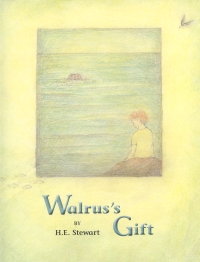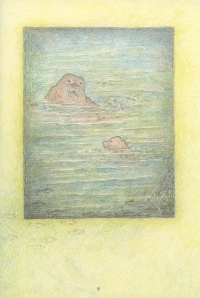| ________________
CM . . .
. Volume XVIII Number 17. . . .January 6, 2012 
 |
Walrus's Gift: Making Friends.
H.E. Stewart.
Victoria, BC: Tudor House Press, 2011.
28 pp., hardcover, $18.00.
ISBN 978-0-9693852-7-1.
Kindergarten-grade 2 / Ages 5-7.
Review by Megan Sorenson.
* /4
|
| |
|

excerpt:
The little walrus delivers one last suggestion from the sea creatures—the boy must try to look inside himself for strength and courage when he feels left out. After all, he has done nothing wrong, nothing to deserve teasing. He is a special child, as is every child. He has his own talents to contribute. And besides, how many children are there who have a walrus for a friend?
Sometimes a book has an important message to share, but its story is overpowered by the emphasis on communicating information. Unfortunately, this is the case with Walrus's Gift. In this story, a young walrus discovers by means of a magic shell that a certain boy is being teased by his classmates. Disguised as a human child, the walrus visits the boy's school to deliver a message from all of the sea creatures about bullying.
An author's note reveals that this book was created in conjunction with the WITS program, which provides education about bullying in elementary schools. Indeed, this instructional agenda is given centre stage in Walrus's Gift, and the narrative indulges in long, didactic passages about the effects of bullying and potential techniques to combat it. As a result, the text comes across as somewhat wooden and stilted and does not lend itself well to being read aloud.
A related issue is that the narrative continually tells rather than shows readers how the characters think and feel. Not only does this lead to some clunky passages, but the boy and the walrus do not emerge as convincing, fleshed out characters with personalities and feelings of their own. Curiously, the narrative keeps the boy and the walrus distanced from one another for most of the story, and important moments of connection are glossed over in a sentence, such as when the visiting walrus-in-disguise "first finds the lonely boy and makes friends with him."
 More troubling than any of these issues, however, is the book's attempt to align itself with First Nations' traditional stories. A note at the back of the text suggests that "Walrus's Gift is in some ways like a native legend. It speaks of the wisdom of elders, of co-operation among the community, and of a search for individual inner strength." Also included is a glossary of the symbolic meanings that various sea creatures have in First Nations culture. This material is problematic both for its stereotypic representation of First Nations culture and for its assumption of a kind of pan-Aboriginal identity that does not differentiate between different First Nations groups. The text makes no mention of collaboration with First Nations individuals or groups, which raises questions about the appropriation of voice.
More troubling than any of these issues, however, is the book's attempt to align itself with First Nations' traditional stories. A note at the back of the text suggests that "Walrus's Gift is in some ways like a native legend. It speaks of the wisdom of elders, of co-operation among the community, and of a search for individual inner strength." Also included is a glossary of the symbolic meanings that various sea creatures have in First Nations culture. This material is problematic both for its stereotypic representation of First Nations culture and for its assumption of a kind of pan-Aboriginal identity that does not differentiate between different First Nations groups. The text makes no mention of collaboration with First Nations individuals or groups, which raises questions about the appropriation of voice.
In terms of layout, the book consistently displays text and illustrations on alternating pages, without much variation. Stewart's simple illustrations fit well with the gentle tone of the text, and her use of intaglio print making techniques on copper plates results in beautifully textured images. However, the illustrations lack the vitality and colour that typically translate into child appeal, and they are surprisingly repetitive; consecutive images frequently show only a slight variation in the poses of the characters.
No one would dispute the fact that bullying is an important issue to discuss with children, but it is unfortunate that the message does not flow naturally from a story and characters that are engaging in and of themselves. The book does succeed in clearly communicating proper steps for dealing with bullying. However, as a story that families and storytime groups could enjoy reading together, Walrus's Gift ultimately fails.
Not recommended.
Megan Sorenson is an MLIS student at the School of Library, Archival and Information Studies in Vancouver, BC.

To comment
on this title or this review, send mail to cm@umanitoba.ca.
Copyright © the Manitoba Library Association. Reproduction for personal
use is permitted only if this copyright notice is maintained. Any
other reproduction is prohibited without permission.
NEXT REVIEW |
TABLE OF CONTENTS FOR THIS ISSUE
- January 6, 2012.
AUTHORS |
TITLES |
MEDIA REVIEWS |
PROFILES |
BACK ISSUES |
SEARCH |
CMARCHIVE |
HOME |

 More troubling than any of these issues, however, is the book's attempt to align itself with First Nations' traditional stories. A note at the back of the text suggests that "Walrus's Gift is in some ways like a native legend. It speaks of the wisdom of elders, of co-operation among the community, and of a search for individual inner strength." Also included is a glossary of the symbolic meanings that various sea creatures have in First Nations culture. This material is problematic both for its stereotypic representation of First Nations culture and for its assumption of a kind of pan-Aboriginal identity that does not differentiate between different First Nations groups. The text makes no mention of collaboration with First Nations individuals or groups, which raises questions about the appropriation of voice.
More troubling than any of these issues, however, is the book's attempt to align itself with First Nations' traditional stories. A note at the back of the text suggests that "Walrus's Gift is in some ways like a native legend. It speaks of the wisdom of elders, of co-operation among the community, and of a search for individual inner strength." Also included is a glossary of the symbolic meanings that various sea creatures have in First Nations culture. This material is problematic both for its stereotypic representation of First Nations culture and for its assumption of a kind of pan-Aboriginal identity that does not differentiate between different First Nations groups. The text makes no mention of collaboration with First Nations individuals or groups, which raises questions about the appropriation of voice.